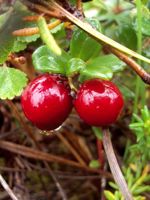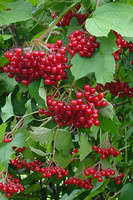Mon-Fri 9am - 5pm Mountain time
Wentworth Highbush Cranberry vs Small Cranberry
Vaccinium oxycoccos
Viburnum trilobum Wentworth
CUSTOM GROW
NOT AVAILABLE THIS SEASON - MIGHT RETURN
Small Cranberry is a native evergreen groundcover found in bogs, fens, and wet meadows. It produces delicate pink flowers that attract a variety of pollinators, including bees, and it serves as both a nectar source and host plant for the Bog Fritillary (Boloria eunomia) butterfly. By late summer, the plant bears deep red berries that are eaten by both wildlife and people. With their high pectin content, the berries are well-suited for making jams and jellies.
Often creeping among sphagnum moss, Small Cranberry thrives in cold, acidic, and nutrient-poor soils (pH 2.9–4.7), making it well adapted to northern wetland environments. With its woody stems, it is technically classified as a shrub and often described as a subshrub or dwarf shrub. It is also valuable for wetland restoration and naturalisation projects.
Note: We use Small Cranberry for Vaccinium oxycoccos. This species is also known by many other common names, including Bog Cranberry, Small Bog Cranberry, and others. Please confirm the scientific name to ensure you are ordering the correct plant.
Wentworth Highbush Cranberry is an ample producer that will make you think of the perfect cranberry sauce when you see it. Its huge fruit is delectable in jellies and sauces. In the spring it bears clusters of white flowers, contrasted against green vegetation that turns a rich red in the fall. Magnificent in garden borders or mass planting, you’ll appreciate your cranberry on your table and in your yard.

